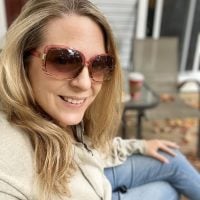You may also need to read this: The Journey from Childhood Trauma to Toxic Relationships.
When I was a child, I was seen as creative and inspirational by my teachers.
My friends in school would get into fights for their right to work with me on a project.
My greatest aspirations were becoming a writer, a psychologist, or an artist of some sort. Never did I think I would become a technologist and work in a medical setting.
What happened?
Unresolved childhood trauma can affect us in many ways; see my previous article, 33 signs of Hidden Childhood Trauma.
~
One of the most important things you can do for your vagina and your sex life—to avoid a world of problems later? Check out this device and get a free bag of craft coffee (code; EJCOFFEE)>>
~
The biggest sign is the low self-esteem we suffer from as victims of child abuse. Our fear of authenticity—instilled by the abuser’s words to shut us down and stop us from speaking up—has long-lasting effects on our ability to speak our truth and create a life we can be in love with.
One day, at 17 years old, I sat in my room at my small creativity desk, where I kept my crystals, journals, and my metaphysical books and items. Images of unicorns in luscious landscapes on postcards hung on the refurbished crates I used as shelving and the legs of my desk. On the desk, I had a small vase with a dried rose in it from a friend, and a pyramid-shaped amethyst.
That day, I asked my true self: what am I supposed to do in this world?
I received images of sigils, geometric shapes with obscure writing inside of it; I was told that I am a transformer, an alchemist, and a peacemaker. But I had no idea how to act on my purpose—nor did I dare to do so—as these things were not commonly accepted. Where I came from, these things were seen as black magic, without question.
I was molded and manipulated into what my parents wanted from me. All my dreams went down the drain. I was just starting a professional training to become a medical laboratory technologist, but I struggled with focusing on my schooling and homework.
I lacked focus from underlying abusive situations that caused me to develop mental and emotional insecurities and extreme shyness, on top of dissociation.
Everything rapidly turned around the minute I moved out and no longer saw my abuser.
But the shyness and insecurities stayed with me for much longer. I was able to salvage my professional training, turn things around, and graduate, but man—it was a struggle to get there.
I kept wondering why life was always such a struggle when I felt it was supposed to flow with ease.
What was I doing wrong?
What was I not seeing that kept me stuck at these lower levels of reality?
I had a hunch but no vocabulary or ability to articulate my struggles, feelings, and thoughts—I was ashamed of most of them.
My insecurities were at play with everything I did in my life: my inability to stand up for what I believed in, my playing shy when ridiculed by others who were stronger than me, and the fear I held when it came to love in relationships.
My ability to bring across my feelings in ways that could be understood—by me and my love interest—was inhibited for some reason.
Sometimes, I tried to speak but no sound came out of my mouth—like I was being smothered, still mentally manipulated by the abusers who had always told me to be quiet.
I never learned how to articulate my feelings, thoughts, and emotions. I was trained to be quiet, like a mouse, and simply bypass problems like they did not exist in order to keep the peace.
I was not embodying the peacemaker I came here to be with this type of behavior, in fact, I was pacifying illusions—that was not peacemaking, it was compliance.
As survivors of childhood trauma, we tend to attract relationships that feel familiar and comfortable, but that is the ultimate problem; if we have not dealt with the underlying pain and issues of our past, we move from one bad relationship to another and often experience trauma bonding, or fall into codependency.
Loving relationships were difficult—I was subconsciously seeking out partners who looked like and acted similarly to my abusers. I was like a sponge, absorbing their love bombing and trying to fill the hole inside of me—but it was a bottomless pit.
I had no ability to return the affection because I had never learned how to do that; love was always given to or taken from me—I never had a say.
I never experienced having privacy, nor had I ever been told to say no to someone who wanted or needed me.
I was trained to be compliant.
This left me severely depleted—emotionally and mentally. And also physically, I lost weight and starved myself; bulimia and anorexia became a way for me to maintain some sort of control or power over my physical being—a false sense of power.
I never had any power nor courage to create what I wanted; my self-esteem and ego died with the death of my innocence.
It takes a true awakening to begin to realize this, to see our own patterns.
What are insecurity and self-consciousness?
They are aspects of fear. It is our fears that keep us from creating an inspiring and passionate life of purpose and success.
It is the programming inherited from abuse that keeps us entrapped in a lower reality, a life we don’t desire.
Fear stops us from taking actions toward our passions:
What if I am exposed?
What if I fail?
What if people knew my darkest secrets?
“What ifs” become the rocks on our path. Greatness only arises through dissolving our fears and expectations created by the programming we were exposed to in childhood.
Resistance within us creates a block to manifesting our dreams.
Learning to understand ourselves better can help us find ways to dissolve our illusions and begin to take inspired actions.
Shedding our self-consciousness and insecurities over being open with our thoughts, inspirations, and creations leads us to create an inspirational life—a life full of true magic.
The doors open when we begin to take action on the insights that come to us.
All we need is courage—the rest will follow when we begin to take inspired action.
Resolving the underlying issues we all carry within our being can help us dissolve the illusions of the past and its effects on us—which will open us widely to the flow of life.
Our perceived vulnerabilities are illusions that we began to incorporate and believe at a young age. These cause us to resist opening up to the vulnerable, genuine flow of life.
Nine steps to release resistance to manifesting the life we want:
1. Acknowledge the resistance.
2. Ask yourself what beliefs you carry that are creating this resistance.
3. Ask yourself if this is based on truth or based on conditioned programming.
4. If based on truth, as an aspect of self or wrong timing, wait to gain perspectives or find a way around it.
5. If based on programming, work on dissolving the illusions within you.
6. Practice taking inspired action to get over your false fears.
7. Release your expectations to the outcome—it takes the pressure off.
8. Do not dismiss the small steps thinking they are invalid; small steps lead to big change.
9. Always have your own back. Be courageously you.
Repeat this mantra daily to put yourself back into the flow of life:
“I can trust myself to know instantly what to do at the right time.”
By releasing our resistances we learn to embrace our courage and see that our fears were unfounded, taking us out of a survival state and into a thriver seat.
~












Read 15 comments and reply